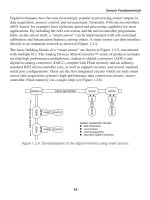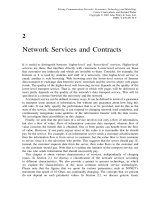Tài liệu Data Communication Principles P2 pptx
Bạn đang xem bản rút gọn của tài liệu. Xem và tải ngay bản đầy đủ của tài liệu tại đây (470.1 KB, 20 trang )
Large File Language/format comparison with recipient Break up into
manageable slices Sequencing and information integrity embedded in each
chunk Routing Combat channel/Link problem physical transmission
In this example, instead of emphasizing on signal type, we care more
about “readability” of the transmitted document. There is no need of format
comparison, breaking up in manageable chunks, sequencing etc. in voice
communication. Even functions common to both voice and file
communications, such as routing, could have different implementations, and
following paragraph explains how.
For speech communication, the gaps in talk spurts occur naturally and
form an essential part of information. It is necessary that these gaps be
maintained at the receiving point. However, such is not the case for a file that
is stored in a directory at the sending end and would be stored at the receiving
end in another directory. In other words, if we use a different path for each
data block of the file with a sequence number stamped on it, we will not lose
any information by having each chunk using different route. We can always
look at the sequence numbers of the received data blocks and put them back
in order. Not only that, if we make quite small, manageable chunks of file, we
can process them individually, as if each one is from a separate user. So, if
one of the chunks is in error, it can be requested again from the sending
computer. In essence, even though both voice and file transfer need routing,
the most suitable mechanism can be substantially different for the two.
The most favorable way for routing voice data is what is called circuit
switching. File like data, on the other hand can best use 'chunk-based-
switching' called packet switching. Here’s a brief account of each (a detailed
discussion will follow in Chapter 2).
1.3.2.1. Circuit Switching
In this switching mechanism, a circuit is allocated to every piece of
complete information (called a call). This circuit allocation is all the way from
the sending to the receiving computer or terminal. It stays in place throughout
the duration of the call until the sending (or receiving) side signals that it is
not needed any more. In more formal terms, we say that a fixed bandwidth is
guaranteed throughout the communication session.
Circuit switching can be used for voice or file communication.
However, it is easily seen that for file communication, it is best to send one
part of file at a time. These chunk or data blocks are called packets. Each
packet of the file may be transmitted via the same or different route. This
allows for the number of additional functions and procedures that can be
performed on each packet. Moreover, it arises a new type of switching, called
packet switching for obvious reasons.
11
1.3.2.2. Packet Switching
In this type of switching, data is broken into smaller data units, called
packets. Inside the network, each packet may be treated as if it were a small,
complete message. The bandwidth can either be guaranteed for all packets or
not. It is best suited for file transfer. However, if enough guarantees can be
provided about the inter-gap times of voice signals, it can be used for voice as
well (called packet voice).
With the brief description of the nature of circuit and packet
switching, it is easy to imagine that packet switching is most suitable for a
data network capable of transporting all kinds of information together.
However, this will result in a lot of processing of information before and
during communication. Classification of these processing functions and
networks makes it easier to keep track of all the communications issues and
their study. Computer communications networks can be classified in many
ways: their geographic scope being one that could be easily described at this
stage.
It must be noted that the following classification is not definition. It is
meant to understand networks mainly from application point of view.
1.4. Classification of Networks
There are several ways of classifying data networks, such as,
geographic scopes, protocol architectures and type of service. Following is a
classification based on (roughly) the geographical scope.
1.4.1. Local Area Networks (LANs)
LANs are (usually) small networks that provide a high-speed physical
and logical connection among a group of stations. They typically encompass a
walk-able geographic area, owned and administered by the user and are
mainly used either for hardware sharing or as access networks for greater
geographical scale. Most commonly used LAN is the Ethernet.
In the example in section 2, the network on each floor or building is
typically a LAN. Combining a few other LANs can also result in a LAN.
1.4.2. Wide Area Networks (WANs)
WANs cover a general geographical area that may vary from a small
office area to the whole world (or even more!). Usually, network providers
and big businesses own such networks. WANs are mostly heterogeneous,
meaning, a large variety of LANs and equipments or other WANs can
constitute a single WAN. An example of a WAN is the Internet. Internet
spans much of the populated world, is administered by different groups at
different locations, and has many other WANs as part of it.
12
1.4.3. Metropolitan Area Networks (MANs)
MANs are networks between a LAN and WAN. They are a type of
interconnecting networks for big businesses in a metropolitan area. Usually,
they have interconnecting (switching) devices instead of user desktop
computers as their nodes, but it is possible to have user computers directly
attached to a MAN.
One way to differentiate among LANs, WANs and MANs is the way
transmission resources are accessed. Typically, LANs have uncontrolled
shared medium, MANs are controlled shared medium access, and WANs
have address-based, switched medium access through a separate network.
There are other types of networks in this classification. More recently,
the term personal area networks (PANs) has got a legitimacy in networking
literature due to the fact that they can be distinguished from other three types.
PANs are networks interconnecting the devices of personal use that could, in
general, be carries around. Examples of such devices are personal digital
assistant (PDA), various wireless phones, remote control, etc. Usually, the
design of these networks entails replacing the wire only, as they aren't
expected to be interconnected via WANs and MANs in near future.
1.5. Network Protocol Architecture
In addition to classifying a network as LAN, MAN or WAN, there is
a structured terminology to describe and identify various parts of the hardware
and software making up a computer communication network. Three most
important terms of this terminology are protocols, standards and network
architecture.
1.5.1. Protocols
Protocols are rules of communication. It is through protocols that
computers can exchange information. Just like humans obey certain rules of
communications, so must the computers. Computers are specific about rules
and cannot guess like humans. They have protocols as part of their software
or hardware interaction and can’t change that unless the software or hardware
is changed or modified.
1.5.2. Standards
Standards are the protocols that have gone through a standardization
process. They are documented by some agency or organization so that a large
number of vendors can get those documents and design systems based on the
same protocols. This takes care of the interoperability issue and helps both
vendors and users. Examples of standardization agencies are; the Internet
Society, International Organization for Standardization (ISO), Institute of
13
Electrical and Electronic Engineers (IEEE) and American National Standards
Institute (ANSI), European Telecommunications Standards Institute (ETSI)
and International Telecommunications Union (ITU).
1.5.3. Protocol Architecture
Every computer and network needs a large number of protocols in
order to complete data communications. The number of protocols can easily
grow into several hundreds for a network. Besides, protocols take many
different forms, from software to hardware, manufactured and designed by
many companies. Different networks may have entirely different sets of
protocols for every function of communications. Therefore, it may be helpful
to classify protocols in groups in order to streamline a network layout.
Automatically, this will help all sections of role players, user, provider and
designer. A set of protocols specific to a network is sometimes called a
protocol suite. When a subset of a protocol suite could be grouped together to
perform functions that can be related to each other in communication terms,
such a subset is often called a layer or level.
1.5.3.1. A Protocol Layer
A protocol layer is a set of protocols that perform a common (larger)
function. Usually, a protocol layer consists a number of protocols. The
concept of layering helps arrange the protocol suite as a set of layers. Then the
job of defining a computer network is really taken in the following steps:
1.
2.
3.
4.
Define protocols in each layer.
Define all the layers needed.
Define interaction among layers in the same computer.
Define interaction among layers on different computers, intermediate
and end stations.
By specifying the above guidelines, all the network communication can
be defined as a set of protocol layers. Such a set of protocol layers is called as
the network architecture.
In essence, a network architecture or protocol architecture is the set of
layers and associated protocol specifications that can achieve complete
communications among two or more computers connected via a network.
1.6. Example of a Protocol Architecture
Example architecture, and by far the most attractive (at least
academically) in networking books, is the Open System Interconnection (OSI)
reference model. This model was recommended by International Organization
for Standardization for open system interconnection (OSI).
14
1.6.1. Open System
The term open system in OSI refers to the fact that the computer
systems using OSI architecture will be open to communications to all systems
designed by any vendor as long as they implement the same protocol
architecture. Thus the specifications of the computer or hardware or operating
systems play no role in interoperability of all the computers using the OSI
architecture.
The OSI reference model (OSI-RM) breaks communications into
seven layers. Each layer has a well-defined scope of its functions clearly
identifiable from other layers. User information enters one layer at a time.
Only one layer is responsible of actually sending the bit stream on the
channel. Layers on the same computer can communicate only with the
adjacent layers. Layers on different computers can communicate only with
their peer layers. With these rules set aside, the user has the flexibility of
shopping around for different layers and adding equipment from many
vendors to an existing network.
1.7. Summary
A computer communications network is a complex system designed
by many different, independent, software, hardware, and communication and
networking professionals. The networking part mainly consists of designing
efficient resource management methods and protocols to effect successful and
reliable communication. Due to a large number of functions expected from
protocols, their organization is very important according to their place in the
process of communication. This may be helped by defining layers and
network architectures. Usually, the design of layers that are closest to physical
transmission is the subject of communications engineering. Logical functions
of communications that are above the physical functions are typically for the
network engineer to resolve. Software professionals deal with the application
developments for stand-alone and networked systems. The applications make
use of the networking protocols to get confidence in the exchanged
information. The information is exchanged through physical circuits (or air)
by either using a fixed path (circuit switching) or some less rigorously defined
path (packet switching).
The study of data communications pertains to the study of all the
layers of a network architecture from wires and cables to signal
characteristics, to protocol definition, specification and coding, to
management of networks. For this book our main emphasis is on the protocols
relating to the physical transmission of bits, logical interpretation of the
exchanged information between directly connected computers, and part of
switching and routing mechanisms to route information through a network of
inter-connected nodes.
15
16
Define a communications protocol?
What is the difference between a protocol and a standard?
What is the difference between a computer operating system (OS) and
1.8. Review Questions
1
:
2
:
3
:
network operating system (NOS)?
4
:
5
:
6
:
7
:
8
:
What is a protocol layer and what is the chief benefit of defining layers?
What is network architecture?
How can a LAN and WAN be differentiated from each other?
What does ISO stand for and what is its purpose?
What does OSI-RM stand for and what is an open system?
A
s seen towards
the end of Chapter 1, protocols are organized into
layers and architectures. We define and distinguish among networks from the
protocol architectures used in their design and operation. In this chapter, we
will look at some of the important reference models and actual protocol
architectures. The first two models considered are most popular academically
as well as in practice. The first is called the open system interconnection
reference model (OSI-RM) and the second is called transmission control
protocol/ Internet protocol (TCP/IP) suite. Perhaps, the reason why it is better
to call TCP/IP as protocol suite instead of network architecture is due to the
lack of strict definition of the lower levels leaving TCP and IP as the most
important protocols. Many protocols of the TCP/IP suite have evolved rather
than being documented in a well-defined layered paradigm. The process of
evolution continues as the Internet outgrows itself and we keep welcoming
new protocols and new versions of existing protocols.
The OSI model is a different story. The International Organization for
Standardization (ISO) proposed this architecture. The ISO was created in
1946 for standards in trade and manufacturing. It has no limit to the items and
categories under its jurisdiction of specifications and has a well-defined
procedure for obtaining them. OSI reference model (OSI-RM) was developed
in prediction of wide use of computer networking in future (which happened
to be the case). Arguably, OSI really set up computer networking as an area
distinct from communications and computer science. However, OSI network
architecture is not as widely implemented as TCP/IP. In spite of that, the OSI-
RM still provides an excellent platform for understanding of networks at
elementary level. There is another reason to include the OSI-RM and TCP/IP
in this chapter, that is, the main protocol examples considered in this text are
proposed by ISO as part of OSI network and are also used with TCP/IP
protocol suite.
In the rest of the chapter, we will look at the characteristics of OSI-
RM, the TCP/IP suite and the protocol architecture for wireless LANs.
Following the examples, we will have a brief discussion on the working of
ISO, Internet Society and some other standardization organizations. In the
end, we will draw a framework for protocol study that may help in
understanding a given protocol, software or hardware, and at any layer or
level.
2. Network Architectures -
Examples
2.1. The OSI Reference Model (OSI-RM)
In the OSI-RM, the network architecture consists of the following
seven layers: layer seven being closest to the user interface.
1.
Physical Layer (PHY) is the protocol layer responsible for physical
interface between a computer and an OSI network.
2. Data Link Control Layer (DLC) is responsible for specifications of the
logical connection across a physical link that directly connects two
communication stations in an OSI network.
3. Network Layer provides specifications for options, mechanisms and
algorithms for routing data through the OSI network.
4. Transport Layer (TL) takes care of the imperfections of network and lower
layers by providing end-to-end reliability functions.
5. Session Layer provides specifications for managing the communication
session between two applications across an OSI network by facilitating the
dialogue and inserting checkpoints in a large sequence of data bits.
6. Presentation Layer provides information syntax and formatting
specifications to facilitate communication between applications that could
otherwise be using different formatting structures.
7. Application Layer provides specifications to design application program
interfaces for OSI networks.
18
2.1.1. OSI-RM Characteristics and Terminology
The reference model assumes a packet-by-packet communications. In
the same stack, a layer can communicate only with the adjacent layers. In
other words, layer number N can exchange messages with either layer number
N+l or N-l. Each layer has an address within the computer. This address is
called a service access point (SAP). A layer interaction with adjacent layers is
shown in Figure 2-1. A different vendor may provide each layer as long as the
protocol specifications are not violated.
The communication via SAPs occurs through the use of programs
called primitives. A primitive is a software program (better yet a procedure or
function) that contains data and other parameters to be transferred to the next
adjacent layer. In OSI terminology, a layer invokes or requests services from
the layer below and provides services to the layer above. Thus, in Figure 2-1,
layer number N provides services to layer number N+l while it requests
services from layer number N-1.
Interlayer communication among communicating computers is
provided as follows. Each layer attaches additional bits to the data that it
receives from the layer above. These bits are variously called header or
trailer, protocol information, protocol header etc. The headers and trailers
are used in communication between peer layers. In other words, the peer-to-
peer protocols are imbedded in the header or trailer of a packet. A data packet









